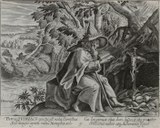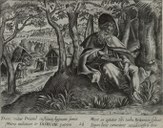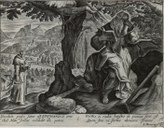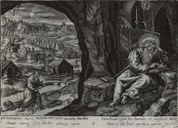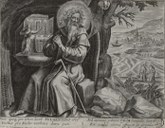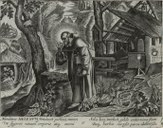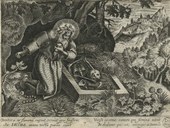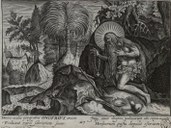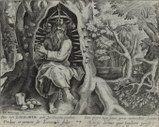Gallery 9:
The Blessed Anchorites of Puebla

Title pages for the five collections of anchorites published in Paris by Jacques Honervogt I ca. 1635. Photos: Bibliothèque Municipale de Lille.
Maarten de Vos (1532-1603) was a prodigious Flemish draftsman whose alluring Mannerist designs were engraved by the hundreds in Northern Europe. Once engraved, these drawings traveled throughout the Spanish empire, serving as models for very many works of art. So many, in fact, that his impact on Spanish Colonial art is considered to be second only to that of Rubens.
At the end of the 16th century Maarten de Vos produced more than a hundred drawings of anchorites --men and women who chose to withdraw from society in order to lead a life focused on prayer, penance, and religious study (see Gallery 8: The Blessed Anchorites of Cuzco). These drawings were promptly assembled into five collections and engraved in Antwerp and in Venice by three of the leading engravers of the time—Johan Sadeler I, Raphael Sadeler I, and Adriaen Collaert. These engravings must have been immensely popular in their day, as they were copied and published in Paris by Thomas de Leu, Jean Leclerc IV, and Jacques Honervogt I early in the 17th century.
It was probably one of the Paris editions of the de Vos anchorites that served as the direct sources for eleven paintings currently at the Museum of the University of Puebla and one in the Francisco J. Ysita del Hoyo Collection. These twelve paintings—plus one we will talk about below—constitute what we have called The Series of the Blessed Anchorites of Puebla. Formerly attributed to Diego de Borgraf, the Flemish painter who emigrated to Puebla, the author of this 17th century series of paintings is now anonymous.
The series of the Blessed Anchorites of Puebla was the object of an important study by Fernando E. Rodríguez-Miaja (see Rodríguez-Miaja 2001). This study succeeded in identifying the indirect sources of all the paintings of the anchorites in the series—namely the engravings by the Sadelers mentioned above. But the Sadeler engravings are reversed relative to the paintings. This suggests that the direct sources of the poblano paintings of the anchorites were not the engravings of the Sadelers, but only engravings based on them. And, of all the re-engravings mentioned above, the one closest to the poblano paintings is that of Jacques Honervogt I [1]. This is, therefore, the set that we have chosen to select as the direct source of these paintings. But this conclusion should not be considered definitive until all the copies of the de Vos anchorites have been studied—not an easy task given the extreme rarity of some of these engravings.
Jacques Honervogt I (ca. 1583 – ca. 1666) was an engraver and publisher that led a workshop located in Paris, at the rue St. Jacques, under the sign of the City of Cologne. It was there that he published his five collections of engravings of the de Vos anchorites in the 1630s (see illustrations above). These engravings were subsequently published, at the same address, by Honervogt's successors: Gérard Jollain I (ca. 1654) and his son François Jollain (1688).
In addition to proposing direct sources for all of the poblano paintings of the anchorites, the correspondences found in this gallery will correctly identify the subject matter of one of the paintings of the series (Saints Euthymius and Theoctistus), locate the whereabouts of a second (Saint Helenus), and identify the engraved source of a third (Saint Onuphrius) [2]. In addition, they will place the thirteenth painting of this series—a Temptation of Christ —in correspondence with one of the engravings of the Evangelicae Historiae Imagines (see Gallery 1). It should perhaps be added that a painting of the temptations of Christ fits within a series of anchorites because, as Rodríguez-Miaja pointed out, this temptation took place when Christ withdrew to the desert as an anchorite in order to pray for forty days and forty nights.
Notes
1. Thus, de Leu does not seem to have published the engraving for one of the poblano paintings, namely that of Saints Euthymius and Theoctistus. In any event, the engraving is not to be found in any of the de Leu collections of de Vos anchorites we have been able to examine at the Bibliothèque Nationale de France, Pitts Theology Library, and Accademia dei Lincei). And the bell seen next to the painting of Fulgentius is lacking in the Leclerc edition.
2. The painting of Saint Onuphrius was not among the ones Mr. Rodríguez-Miaja was able to study. Fortunately, this painting is now in view at the Museum of the University of Puebla. It was there that we were able to study it in 2010. PESSCA is indebted to Denise Beck Garreaud and Marcela Corvera Poiré for the support they provided to the research that led to the installation of this gallery.







